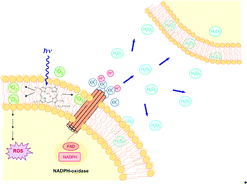Spatial and temporal dynamics of in vitro photodynamic cell killing: extracellular hydrogen peroxide mediates neighbouring cell death†
Abstract
Photodynamic killing of a cell population is generally considered to result from direct effects that occur in each cell. In some scenarios this may be an over-simplification and the potential for cell–cell signaling processes to contribute to the response of a population to photodynamic stress is addressed in this paper. Photodynamic killing of EMT6 cells in culture was studied in time and space using computerized

- This article is part of the themed collection: Microscopy beyond imaging: space-resolved photochemistry and photobiology

 Please wait while we load your content...
Please wait while we load your content...